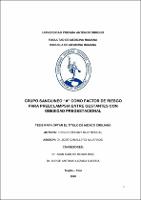Grupo sanguíneo “A“ como factor de riesgo para preeclampsia entre gestantes con obesidad pregestacional

View/
Download
(application/pdf: 313.9Kb)
(application/pdf: 313.9Kb)
Date
2018Author(s)
Ruiz Roncal, Kriss Estefany
Metadata
Show full item recordAbstract
OBJETIVO: Determinar si el grupo sanguíneo A es factor de riesgo para el
desarrollo de preeclampsia en gestantes con obesidad pregestacional
durante el periodo de tiempo comprendido entre enero del 2014 a diciembre
del 2016 en los hospitales de Belén y Regional de Trujillo.
MATERIAL Y MÉTODO: Se realizó un estudio observacional, analítico,
retrospectivo de casos y controles poblacional. El proceso de selección fue
realizado bajo los criterios de inclusión y exclusión en las gestantes con
obesidad pregestacional de los hospitales mencionados entre el periodo de
Enero del 2014 a Diciembre del 2016, registrando un total de 785 pacientes.
Del cual 343 constituyeron el grupo de casos; el resto de gestantes sin
preeclampsia fueron 442, de ellas se seleccionaron de manera aleatoria 343
para el grupo de controles.
RESULTADOS: Se realizó un análisis bivariado de las características
generales del estudio el cual mostró que las variables con mayor
significancia (p < 0,05), fueron la nuliparidad que está dentro de la paridad
categorizada con un p = 0,014, el número de controles con un p = 0,021 y la
edad gestacional del parto con un p < 0,001. De las gestantes con obesidad
pregestacional que presentaron preeclampsia el 81,34 % tuvieron el grupo
sanguíneo “O” con un ORc IC 95% 1,55 [1,08-2,23], con un p = 0,017; y el
11,37% tuvieron el grupo sanguíneo “A” con un ORc IC 95% 0,52 [0,34-0,79],
con un p = 0,002. OBJECTIVE: To determine if blood group A is a risk factor for the
development of preeclampsia in pregnant women with pregestational obesity
during the period from January 2014 to December 2016 in the hospitals of
Belen and Regional of Trujillo.
MATERIAL AND METHODS: An observational, analytical, retrospective
study of population cases and controls was carried out. The selection process
was carried out under the inclusion and exclusion criteria in pregnant women
with pregestational obesity in the mentioned hospitals between the period of
January 2014 to December 2016, registering a total of 785 patients. Of which
343 constituted the group of cases; the rest of pregnant women without
preeclampsia were 442, of whom 343 were randomly selected for the group
of control.
RESULTS: A bivariate analysis of the general characteristics of the study was
carried out, which showed that the variables with the greatest significance (p
<0.05) were the nulliparity that is within the parity categorized with p = 0.014,
the number of controls with p = 0.021 and the gestational age of childbirth
with p <0.001. Of the pregnant women with pregestational obesity who
presented preeclampsia, 81.34% had blood group ““O““ with a 95% ORc 1.55
[1.08-2.23], with p = 0.017; and 11.37% had blood group ““A““ with an ORc IC
95% 0.52 [0.34-0.79], with p = 0.002.
Subject
Collections
- Medicina Humana [2969]

